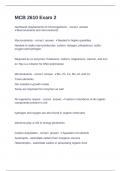Exam (elaborations)
MCB 2610 Exam 2 Question and answers verified to pass 2024/2025
- Course
- Institution
MCB 2610 Exam 2 Question and answers verified to pass 2024/2025 MCB 2610 Exam 2 Nutritional requirements of microorganisms - correct answer Macronutrients and micronutrients Macronutrients - correct answer Needed in higher quantities Needed to make macromolecules: carbon, nitrogen, pho...
[Show more]



